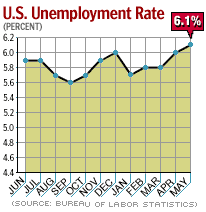NEW YORK (CNN/Money) - Though U.S. unemployment is at its highest level since July 1994, it's still a lot lower than its peaks after recessions in the early 1980s and 1990s.
But these are the aughts, not the '80s or '90s; the economy is different, and most economists say the standard for unemployment is different, too.
Unemployment hit 6.1 percent in May, the Labor Department said recently. While the rate was nearly a nine-year high, it still was a far cry from the 7.8 percent peak it hit after the 1990-91 recession and the nasty 10.8-percent peak it hit in 1982.

In fact, 6 percent unemployment was -- in the early 1990s -- considered by many economists to be "full employment," or labor-market nirvana, the level at which the economy was growing strongly, but not so strongly that it fueled inflation.
That level is probably much lower today, however -- the Congressional Budget Office, for example, believes 5.2 percent unemployment is the new standard for full employment.
"I've spent the past couple of days in Washington, talking to people at the Federal Reserve and the [White House] Council of Economic Advisers, and this issue came up," said Sung Won Sohn, chief economist at Wells Fargo & Co. "The consensus seems to be that an unemployment rate representing full employment is somewhere between 5 and 5.5 percent."
New economy, new unemployment rate
There are several reasons that the "perfect" unemployment rate has fallen. For one thing, the development of radical new technologies in the 1990s created new industries and job opportunities, even as they cut the amount of labor businesses needed to produce goods. That higher productivity pushes overall prices lower, meaning higher employment will be less likely to fuel inflation.
| Related stories
|

|
|
|
|
And the labor force has grown much larger; 6.1 percent unemployment in 1994 meant 7.9 million people were out of work; now, 6.1 percent unemployment means 9 million people are jobless.
Gus Faucher, senior economist at Economy.com, also pointed out that the labor force has grown older and more skilled, meaning workers should stay employed longer and be unemployed for shorter periods of time.
"The 'full employment' unemployment rate is about 5 percent," Faucher said. "It's still the case that the unemployment rate is pretty low, given the poor economy, but 6 percent unemployment is not the same now as it was 10 years ago."
And today's unemployment rate could be much higher -- if the 4.7 million people who want a job but have given up looking all started looking for work again, thus rejoining the labor force, the unemployment rate would skyrocket to 9.1 percent.
Most economists believe the economy needs to grow to its full potential -- a rate of about 3.5 percent per year -- for a sustained time, possibly a year or more, before unemployment falls back to 5 percent.
Right now, most economists hope that sort of growth pattern will get started in the third quarter -- but stronger growth will mean a lot of those 4.7 million people will start looking for work again and rejoin the labor force, meaning the unemployment rate will probably rise for a few months before it starts to fall.
Should sights be set even lower?
An eventual decline to 5 percent unemployment won't be enough to satisfy some economists, however, who think unemployment could be even lower. It fell all the way to 4 percent in 2000 and occasionally dipped even lower, without triggering inflation.
While many economists dismiss this super-low unemployment rate as a symptom of the enormous stock and investment bubble of the late 1990s -- a situation unlikely to be duplicated anytime soon -- others think it's possible to get back to that unemployment rate in a more stable environment.
"The full employment situation reinforces itself," said former Labor Department economist Jared Bernstein, now with the Economic Policy Institute and co-author of a recent book, "The Benefits of Full Employment," which urges policy makers to aim for much lower unemployment.
"When unemployment is that low, wages are growing broadly, and family incomes are rising," Bernstein said. "Wage-based demand growth keeps the economy growing at potential."

|

